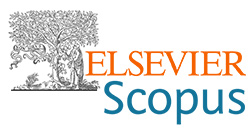Corrosion inhibition efficiency of the Myrrh Gum on API 5CTP110 tubing in hydrochloric acid
DOI:
https://doi.org/10.62638/ZasMat1393Apstrakt
The corrosion inhibition properties of Myrrh Gum (MG) on API 5CT P110 tubing in 0.5 M HCl solution were investigated using electrochemical techniques, including electrochemical impedance spectroscopy and potentiodynamic polarization. The study demonstrated that MG exhibits exceptional inhibitory performance, achieving an efficiency of 92% at an optimal concentration of 3 g/L. The analysis revealed that the adsorption of MG molecules onto the steel surface follows the Langmuir isotherm model, indicating a process dominated by physical adsorption. Additionally, MG acts as a mixed-type inhibitor, effectively mitigating both anodic and cathodic reactions. These findings highlight the potential of Myrrh Gum as a cost-effective and environmentally friendly corrosion inhibitor for industrial applications, particularly in acidic environments. The use of MG aligns with sustainable practices, providing a viable alternative to traditional synthetic inhibitors and contributing to the development of green corrosion prevention strategies.
Ključne reči:
Eco-friendly corrosion inhibitor, API 5CT P110 tubing, Myrrh Gum, Hydrochloric acid, EISReference
K. Haruna, I. Obot, N. Ankah, A. Sorour, T. Saleh (2018) Gelatin: A green corrosion inhibitor for carbon steel in oil well acidizing environment, J. Mol. Liq., 264, 515-525. https://doi.org/10.1016/j.molliq.2018.05.058.
W. Zhang, H.-J. Li, M. Wang, L.-J. Wang, F. Shang, Y.-C. Wu (2018) Halogen-substituted acridines as highly effective corrosion inhibitors for mild steel in acid medium, J. Phys. Chem. C, 122, 25349-25364. https://doi.org/10.1021/acs.jpcc.8b07015.
A.H. Alamri (2020) Localized corrosion and mitigation approach of steel materials used in oil and gas pipelines – An overview, Eng. Fail. Anal., 116, 104735. https://doi.org/10.1016/j.engfailanal.2020.104735.
M.A.M. El-Haddad, A. Bahgat Radwan, M.H. Sliem, W.M.I. Hassan, A.M. Abdullah (2019) Highly efficient eco-friendly corrosion inhibitor for mild steel in 5 M HCl at elevated temperatures: experimental & molecular dynamics study, Sci. Rep., 9, 3695. https://doi.org/10.1038/s41598-019-40149-w.
M. Goyal, S. Kumar, I. Bahadur, C. Verma, E.E. Ebenso (2018) Organic corrosion inhibitors for industrial cleaning of ferrous and non-ferrous metals in acidic solutions: A review, J. Mol. Liq., 256, 565-573. https://doi.org/10.1016/j.molliq.2018.02.045.
A. Singh M.A. Quraishi (2015) Acidizing corrosion inhibitors: a review, J. Mater. Environ. Sci, 6, 224-235.
D. Dwivedi, K. Lepková, T. Becker (2017) Carbon steel corrosion: a review of key surface properties and characterization methods, RSC Adv., 7, 4580-4610. DOI: https://doi.org/10.1039/C6RA25094G
A. Frignani, C. Monticelli, F. Zucchi, G. Trabanelli (2014) Acetylenic alcohols as inhibitors of iron acid corrosion. Improvement of the inhibition efficiency of a class of substances based on their action mechanism, Int. J. Corros. Scale Inhib, 3, 105. https://doi.org/10.17675/2305-6894-2014-3-2-105-119.
M. Salman, K. Ansari, V. Srivastava, D.S. Chauhan, J. Haque, M. Quraishi (2021) Chromeno naphthyridines based heterocyclic compounds as novel acidizing corrosion inhibitors: Experimental, surface and computational study, J. Mol. Liq., 322, 114825. https://doi.org/10.1016/j.molliq.2020.114825.
M. Galai, M.E. Touhami, M. Oubaaqa, K. Dahmani, M. Ouakki, M. Khattabi, Z. Benzekri, R. lachhab, S. Kaya, N. Bulut, S. Briche, S. Boukhris (2023) Electrochemical, Characterization, and Quantum Chemical Studies of Two Newly Synthesized Aromatic Aldehydes-Based Xanthene Diones as Corrosion Inhibitors for Mild Steel in 1 M Hydrochloric Acid, J. Bio- Tribo-Corros., 9, 63. https://doi.org/10.1007/s40735-023-00778-1.
J. Wang, L. An, J. Wang, J. Gu, J. Sun, X. Wang (2023) Frontiers and advances in N-heterocycle compounds as corrosion inhibitors in acid medium: Recent advances, Adv. Colloid Interface Sci., 103031. https://doi.org/10.1016/j.cis.2023.103031.
M. Yadav, S. Kumar, P. Yadav (2013) Corrosion Inhibition of Tubing Steel during Acidization of Oil and Gas Wells, J. Pet. Eng., 2013. https://doi.org/10.1155/2013/354630.
D. Singh A. Dey (1993) Synergistic effects of inorganic and organic cations on inhibitive performance of propargyl alcohol on steel dissolution in boiling hydrochloric acid solution, Corrosion, 49, 594-600. https://doi.org/10.5006/1.3316090.
F.G. Liu, M. Du, J. Zhang, M. Qiu (2009) Electrochemical behavior of Q235 steel in saltwater saturated with carbon dioxide based on new imidazoline derivative inhibitor, Corros. Sci., 51, 102-109. https://doi.org/10.1016/j.corsci.2008.09.036.
X. Li, S. Deng, H. Fu, G. Mu (2010) Synergistic inhibition effect of rare earth cerium(IV) ion and sodium oleate on the corrosion of cold rolled steel in phosphoric acid solution, Corros. Sci., 52, 1167-1178. https://doi.org/10.1016/j.corsci.2009.12.017.
X. Li, S. Deng, H. Fu, G. Mu (2009) Synergistic inhibition effect of rare earth cerium(IV) ion and 3,4-dihydroxybenzaldehye on the corrosion of cold rolled steel in H2SO4 solution, Corros. Sci., 51, 2639-2651. https://doi.org/10.1016/j.corsci.2009.06.047.
S.Y. Al-Nami A.E.-A.S. Fouda (2020) Corrosion Inhibition Effect and Adsorption Activities of methanolic myrrh extract for Cu in 2 M HNO3, Int. J. Electrochem. Sci., 15, 1187-1205. https://doi.org/10.20964/2020.02.23.
B. Tan, B. Xiang, S. Zhang, Y. Qiang, L. Xu, S. Chen, J. He (2021) Papaya leaves extract as a novel eco-friendly corrosion inhibitor for Cu in H2SO4 medium, J. Colloid Interface Sci., 582, 918-931. https://doi.org/10.1016/j.jcis.2020.08.093.
N. Hossain, M. Asaduzzaman Chowdhury, M. Kchaou (2021) An overview of green corrosion inhibitors for sustainable and environment friendly industrial development, J. Adhes. Sci. Technol., 35, 673-690. https://doi.org/10.1080/01694243.2020.1816793.
M. Rinaudo (2014) Biomateriales basados en un polisacárido natural: el alginato, TIP Revista Especializada en Ciencias Químico-Biológicas, 17, 92-96.
H. Hu, J. Li, W. Jiang, Y. Jiang, Y. Wan, Y. Wang, F. Xin, W. Zhang (2024) Strategies for the biological synthesis of D-glucuronic acid and its derivatives, World J. Microbiol. Biotechnol., 40, 94. https://doi.org/10.1007/s11274-024-03900-8.
A. Wadouachi J. Kovensky (2011) Synthesis of Glycosides of Glucuronic, Galacturonic and Mannuronic Acids: An Overview, Molecules, 16, 3933-3968. https://doi.org/10.3390/molecules16053933.
A. Richel, F. Nicks, P. Laurent, B. Wathelet, J.-P. Wathelet, M. Paquot (2012) Efficient microwave-promoted synthesis of glucuronic and galacturonic acid derivatives using sulfuric acid impregnated on silica, Green Chemistry Letters and Reviews, 5, 179-186. https://doi.org/10.1080/17518253.2011.607852.
C.-S. Wu (2009) Renewable resource-based composites of recycled natural fibers and maleated polylactide bioplastic: Characterization and biodegradability, Polym. Degrad. Stab., 94, 1076-1084. https://doi.org/10.1016/j.polymdegradstab.2009.04.002.
A. Singh, K.R. Ansari, D.S. Chauhan, M.A. Quraishi, H. Lgaz, I.-M. Chung (2020) Comprehensive investigation of steel corrosion inhibition at macro/micro level by ecofriendly green corrosion inhibitor in 15% HCl medium, J. Colloid Interface Sci., 560, 225-236. https://doi.org/10.1016/j.jcis.2019.10.040.
M. Djellab, H. Bentrah, A. Chala, H. Taoui, S. Kherief, B. Bouamra (2020) Synergistic effect of iodide ions and bark resin of Schinus molle for the corrosion inhibition of API5L X70 pipeline steel in H2SO4, Mater. Corros., 71, 1276-1288. https://doi.org/10.1002/maco.202011533.
D. Wang, Y. Li, B. Chen, L. Zhang (2020) Novel surfactants as green corrosion inhibitors for mild steel in 15% HCl: Experimental and theoretical studies, Chem. Eng. J., 402, 126219. https://doi.org/10.1016/j.cej.2020.126219.
S.A. Umoren (2016) Polypropylene glycol: A novel corrosion inhibitor for ×60 pipeline steel in 15% HCl solution, J. Mol. Liq., 219, 946-958. https://doi.org/10.1016/j.molliq.2016.03.077.
M. Djellab, H. Bentrah, A. Chala, H. Taoui (2019) Synergistic effect of halide ions and gum arabic for the corrosion inhibition of API5L X70 pipeline steel in H2SO4, Mater. Corros., 70, 149-160. https://doi.org/10.1002/maco.201810203.
R. Solmaz, G. Kardaş, M. Çulha, B. Yazıcı, M. Erbil (2008) Investigation of adsorption and inhibitive effect of 2-mercaptothiazoline on corrosion of mild steel in hydrochloric acid media, Electrochim. Acta, 53, 5941-5952. https://doi.org/10.1016/j.electacta.2008.03.055.
I.B. Obot, A. Meroufel, I.B. Onyeachu, A. Alenazi, A.A. Sorour (2019) Corrosion inhibitors for acid cleaning of desalination heat exchangers: Progress, challenges and future perspectives, J. Mol. Liq., 296, 111760. https://doi.org/10.1016/j.molliq.2019.111760.
H. Taoui, H. Bentrah, A. Chala, M. Djellab (2019) Bark resin of Schinus molle as an eco-friendly inhibitor for API 5L X70 pipeline steel in HCl medium, Mater. Corros., 70, 511-520. https://doi.org/10.1002/maco.201810477.
O. Sotelo-Mazon, S. Valdez, J. Porcayo-Calderon, M. Casales-Diaz, J. Henao, G. Salinas-Solano, J.L. Valenzuela-Lagarda, L. Martinez-Gomez (2019) Corrosion protection of 1018 carbon steel using an avocado oil-based inhibitor, Green Chemistry Letters and Reviews, 12, 255-270. https://doi.org/10.1080/17518253.2019.1629698.
M.M. Solomon, S.A. Umoren, A.U. Israel, I.G. Etim (2016) Synergistic inhibition of aluminium corrosion in H2SO4 solution by polypropylene glycol in the presence of iodide ions, Pigment Resin Technol., 45, 280-293. https://doi.org/10.1108/PRT-01-2015-0010.
H. Bentrah, Y. Rahali, A. Chala (2014) Gum Arabic as an eco-friendly inhibitor for API 5L X42 pipeline steel in HCl medium, Corros. Sci., 82, 426-431. https://doi.org/10.1016/j.corsci.2013.12.018.
E. Ebenso, N. Eddy, A. Odiongenyi (2009) Corrosion Inhibition and Adsorption Properties of Methocarbamol on Mild Steel in Acidic Medium, Port. Electrochim. Acta, 27, 13-22. https://doi.org/10.4152/pea.200901013.
S. Kherief, M. Djellab, H. Bentrah, A. Chala, B. Bouamra, H. Taoui (2023) Corrosion Inhibition Efficiency of Ghars Date Extract on API 5L X70 Pipeline Steel in Hydrochloric Acid, Protection of Metals and Physical Chemistry of Surfaces, 59, 1306-1314. https://doi.org/10.1134/S2070205123701162.







